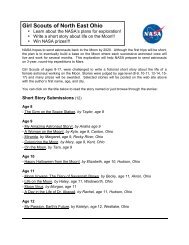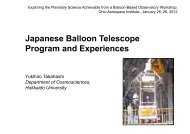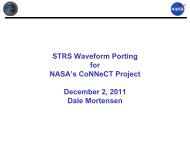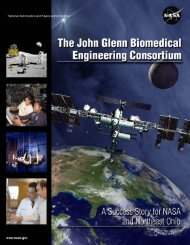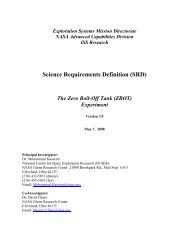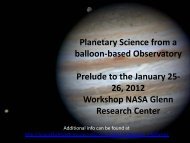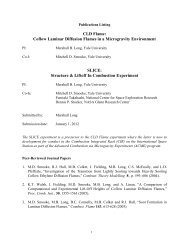Amusement Park Physics With a NASA Twist - Space Flight Systems ...
Amusement Park Physics With a NASA Twist - Space Flight Systems ...
Amusement Park Physics With a NASA Twist - Space Flight Systems ...
Create successful ePaper yourself
Turn your PDF publications into a flip-book with our unique Google optimized e-Paper software.
define zero to be at the lowest point of the ride (see<br />
diagram). Using this frame of reference, when the rider<br />
moves downward from the starting height, the displacement<br />
is negative. Note, nothing has changed other than the<br />
location of the ruler, which defines the frame of reference<br />
and the location of zero. The motion of the ride will still be<br />
the same. Frames of reference are often defined in such a<br />
way as to make calculations as simple as possible.<br />
The starting height at 30 meters, which is<br />
above the ground level, and the ending<br />
height at 0 meters, which is ground level.<br />
The starting height is above the ground<br />
level at 30 meters, and the ending height<br />
is also above ground level at 0 meters.<br />
Displacement, velocity, and<br />
acceleration have both magnitude<br />
(size) and direction.<br />
Velocity<br />
Determining the velocity of a ride will tell you how fast the ride<br />
is falling at any given moment (e.g., 5 meters per second), or<br />
how fast the ride’s position is changing. It will also tell you the<br />
direction in which the ride is moving. One can use a stopwatch<br />
to help calculate velocity. To find the average velocity, divide the<br />
displacement by the change in time. The formula is V ave =<br />
(x f – x i )/(t f – t i ). V ave stands for the average velocity, x f is the<br />
final horizontal position, x i is the initial horizontal position, t f is<br />
the final time, and t i is the initial time. Our free-fall ride takes<br />
about 2.5 seconds to fall 30 meters so its average velocity<br />
is V ave = (0 meters – 30 meters)/(2.5 seconds – 0 seconds) =<br />
–12 meters/second. The velocity is negative because the<br />
direction of motion is downward.<br />
The difficulty is that part of the time the free-fall ride is<br />
moving slower than 12 meters/second and the rest of the<br />
time it is moving faster. In this case, one may also want to<br />
know the instantaneous velocity, which is the speed and<br />
direction of motion at an instant in time. If one had more<br />
position and time data points, one could plot these ordered<br />
pairs on graph paper. The slope of a line drawn between any<br />
two points on the resulting curve is the average velocity of<br />
the car moving between the two positions. The instantaneous<br />
velocity at any given time is the slope of the line<br />
tangent to the curve at that time.<br />
Acceleration<br />
The rate at which velocity changes is called acceleration.<br />
The change can be in speed, direction, or both. For the freefall<br />
ride, the acceleration is considered to be a constant of<br />
9.8 meters/second 2 due to Earth’s gravity. Thus, acceleration<br />
in a free-fall ride is a change in velocity. However, in a roller<br />
coaster, the acceleration in many instances is not just a<br />
change in speed caused by gravity. In some sections of the<br />
roller coaster, such as a loop-de-loop, the direction in which<br />
the roller coaster is moving also changes.<br />
16<br />
<strong>Amusement</strong> <strong>Park</strong> <strong>Physics</strong> <strong>With</strong> a <strong>NASA</strong> <strong>Twist</strong><br />
EG–2003–03–010–GRC



